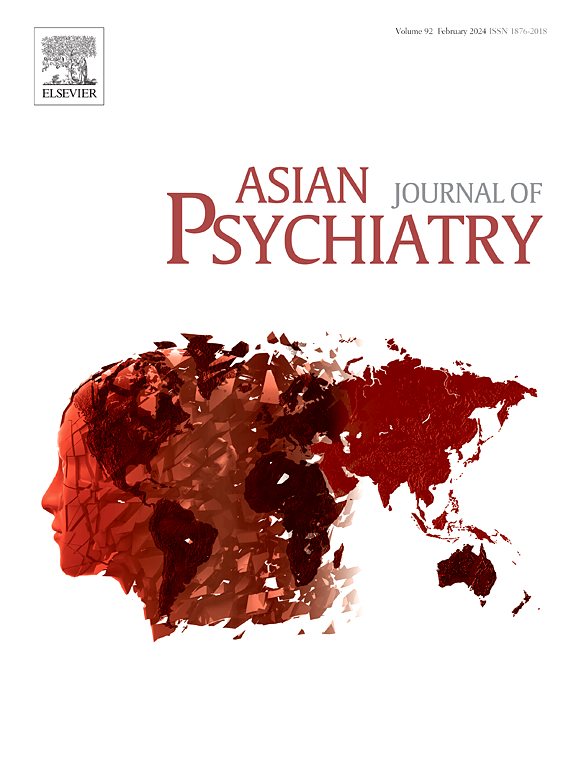The role of neuroinflammation in schizophrenia: Focus on Th17 cells functions
IF 4.5
4区 医学
Q1 PSYCHIATRY
引用次数: 0
Abstract
Schizophrenia is a severe mental disorder associated with behavioural, cognitive, and emotional impairments. There are several leading theories on schizophrenia etilology, including genetic, neurotransmitter (dopamine and GABA-glutamate are the leading ones), immunological (microglial, cytokine, kynurenine) and neurodevelopmental (neuro-ontogenetic and neurodegenerative) theories. Despite the fact that in recent decades, the greatest efforts have been directed towards testing and developing genetic and neurotransmitter (including dopamine) theories, the recent evidence suggests that immunological aspects, in particular neuroinflammation (cytokine hypothesis) may play an important role in schizophrenia. Neuroinflammation in schizophrenia is thought to be mediated primarily by the activation of resident immune cells such as microglia. However, peripheral immune cells, which migrate through the blood-brain barrier into the central nervous system (CNS) are also involved in the development of neuroinflammation. Among the infiltrating cells that cause neuroinflammation, CD4+ T helper (Th) 17 cells attract the most attention. These cells produce proinflammatory cytokines, increase the permeability of the blood-brain barrier, and activate resident microglia. The critical role of Th17 cells in the development of demyelinating and neurodegenerative diseases of the CNS has been established. In addition, the pathogenic role of Th17 cells in mental disorders such as depression and general anxiety disorder has also been demonstrated. In this report, we reviewed the recent evidence supporting the involvement of the Th17 cells in the pathogenesis of schizophrenia. Based on in vivo and in vitro studies, we suggest that Th17 cells could be considered as a promising additional therapeutic target in schizophrenia and deserve further investigation.
神经炎症在精神分裂症中的作用:关注Th17细胞的功能
精神分裂症是一种与行为、认知和情感障碍相关的严重精神障碍。精神分裂症病因学有几个主要的理论,包括遗传学、神经递质(多巴胺和gaba -谷氨酸是主要的)、免疫学(小胶质细胞、细胞因子、犬尿氨酸)和神经发育(神经个体发生和神经退行性)理论。尽管近几十年来,最大的努力都是针对测试和发展遗传和神经递质(包括多巴胺)理论,但最近的证据表明,免疫方面,特别是神经炎症(细胞因子假说)可能在精神分裂症中发挥重要作用。精神分裂症中的神经炎症被认为主要是由驻留免疫细胞如小胶质细胞的激活介导的。然而,通过血脑屏障进入中枢神经系统(CNS)的外周免疫细胞也参与了神经炎症的发展。在引起神经炎症的浸润细胞中,CD4+ T辅助(Th) 17细胞最受关注。这些细胞产生促炎细胞因子,增加血脑屏障的渗透性,并激活驻留的小胶质细胞。Th17细胞在中枢神经系统脱髓鞘和神经退行性疾病发展中的关键作用已经确立。此外,Th17细胞在抑郁症、广泛性焦虑症等精神障碍中的致病作用也已得到证实。在这篇报道中,我们回顾了最近支持Th17细胞参与精神分裂症发病机制的证据。基于体内和体外研究,我们认为Th17细胞可以被认为是精神分裂症的一个有希望的额外治疗靶点,值得进一步研究。
本文章由计算机程序翻译,如有差异,请以英文原文为准。
求助全文
约1分钟内获得全文
求助全文
来源期刊

Asian journal of psychiatry
Medicine-Psychiatry and Mental Health
CiteScore
12.70
自引率
5.30%
发文量
297
审稿时长
35 days
期刊介绍:
The Asian Journal of Psychiatry serves as a comprehensive resource for psychiatrists, mental health clinicians, neurologists, physicians, mental health students, and policymakers. Its goal is to facilitate the exchange of research findings and clinical practices between Asia and the global community. The journal focuses on psychiatric research relevant to Asia, covering preclinical, clinical, service system, and policy development topics. It also highlights the socio-cultural diversity of the region in relation to mental health.
 求助内容:
求助内容: 应助结果提醒方式:
应助结果提醒方式:


